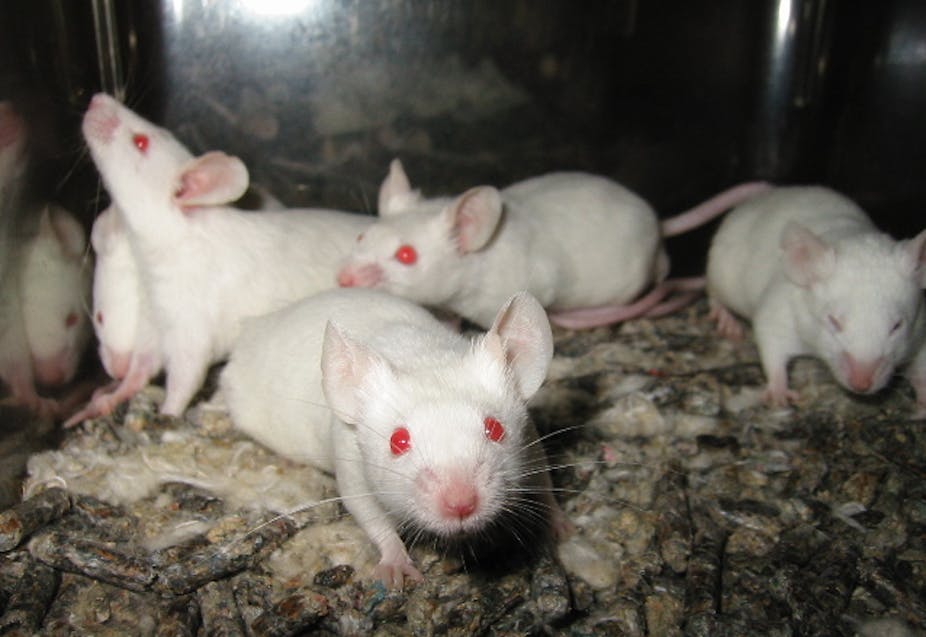Animal testing is on the rise in the UK, according to Home Office figures. The figures suggest that the government’s plan to reduce its use in scientific research hasn’t been successful so far, and much of the increase may be due to an increase in genetically altered animals, primarily mice and fish.
But although animal research is still necessary to test new drugs before human trials, we’re increasingly finding ways to test new substances on alternatives. This is important not just to reduce animal use but also to improve the quality of the science that is carried out for the benefit of human health.
Rodents can’t vomit
Cells in our tissues recognise many substances, such as hormones or neurotransmitters - the chemicals that are released from nerves which control what the cell does, for example contracting a muscle cell.
To study the receptors that pick up these signals, we clone them and insert them into a “host cell” that can be easily grown in a lab. From there we can start to test new drugs and to see what effect they have on the living cell. To understand how the receptors, and the drugs we take, control wider body functions, the next step usually involves studying animals in laboratories - often rodents like rats, mice and guinea-pigs.
But human receptors in host cells don’t always behave in the same way as they would in the body, which can give scientists misleading data. And some human receptors aren’t found in rodents, or if they are, have different functions. This makes it difficult to properly predict the functions of the receptors and as a result, expensive clinical trials on new drugs can fail.

The gut is a good example: it has basic functions that are similar in both humans and other animals. But there are some surprising and remarkable differences. Most obvious is that rodents can’t vomit.
Their guts also lack certain hormones found in humans, and different ones that respond to nausea-inducing stimuli. Certain receptors are structured differently and respond differently when given the same stimuli.
Rodents also possess a large caecum, which in humans has shrunk to become our appendix, and drugs and hormones have different functions in human and rodent intestines.
There’s also an extraordinary variation between highly in-bred “strains” of laboratory mice, each of which is distinguished from the other by millions of small genetic variations - so the argument for uniformity isn’t entirely true. And for each molecular change, who’s to say which strain is more or less predictable than what happens in humans?
Setting up a human tissue lab
One solution to these problems is to study the functions of human tissues (removed as a normal part of surgery) - using human tissues to understand human disease. This improves both the quality of the science and reduces the numbers of animals used in research.

Changes in human tissue structures caused by disease are commonly studied and “banks” of tissues have been frozen or preserved for future use. But it’s less common to study their functions when tissues have to be kept alive and studied almost immediately after being removed from the body.
To study human tissue functions requires clear collaboration between a whole host of medical staff, from surgeons, theatre staff, pathologists, scientists and also the patients themselves, who need to give their consent. And this is what we’ve been doing.
It’s clear that using human tissues reduces animal use. Both directly - for example, up to 16 different preparations may be cut from a single human specimen in experiments looking at gastrointestinal muscle contractions, which requires four to eight different mice to achieve the same outcome - and indirectly, by demonstrating which animal experiments don’t reflect what happens in humans and calling for an end to them.
Ethical collection of tissues
Tissues need to be collected and used ethically. Nearly all patients are happy for redundant surgical tissue to be used for research. However, the Alder Hey scandal in 1999, which involved the unauthorised removal and retention of human tissue, including children’s organs, forced the international research community to tighten research rules.

Access to human tissue for research now requires ethics documentation and informed consent. It’s standard practice to ensure there’s no direct link between the tissue and the identity of the patient.
In our team, a “point person”, operating on behalf of different scientists, ensures consent and liaises between the surgeon and pathologist. This means that tissues are promptly collected “fresh” from the operating theatre and are not placed in formalin, or formaldehyde, which is normal practice.
After a pathologist has dissected a research sample and taken all they need, we can then use it to carry out experiments.
Although the risk is low, there is always a possibility that the tissue has been removed from a patient with a transmissible infection. So scientists use special equipment to protect themselves from inhaling potentially contaminated aerosols from the nutrient solution the tissues are placed in and bubbled with oxygen to keep them alive. Tissues from patients with known transmissible infections aren’t collected.
Humans vary too
Mice vary. But so do humans - donors might be male or female and different ages. They might also enjoy a hedonistic or abstinent lifestyle. This means that when anyone claims that human tissue research is better than using laboratory animals, there is always the counter-claim that animal research is more precise, with fewer variables.
But variation can be reduced by surgical techniques that minimise damaging the tissue during removal. Collection of basic patient details (age, gender, disease, regular medications taken) and attention to other variables such as tissue recovery times, means human tissue research approaches the precision that is expected from animal studies.

